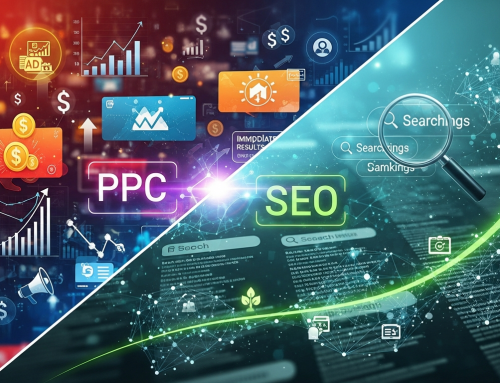Introduction: Beyond Organic vs. Paid
In the realm of digital marketing, the ongoing discussion regarding Search Engine Optimization (SEO) and Pay-Per-Click (PPC) advertising frequently highlights their distinctions: SEO is a gradual and organic process, whereas PPC offers immediate results and requires payment. Marketers often perceive them as distinct entities, allocating budgets and resources separately.
Nevertheless, the key to achieving genuine online supremacy does not reside in selecting one method over the other, but rather in understanding their potent collaboration. Consider your PPC campaign as a costly, real-time A/B testing facility that continuously collects conversion data and user intent signals. Rather than perceiving your Google Ads expenditure merely as an expense, view it as an investment in high-quality data that can be directly utilized to refine and expedite your organic SEO strategy.
Section 1: PPC as Your Keyword Lab
PPC campaigns offer immediate, quantifiable feedback on keyword performance that SEO simply cannot. You can launch an ad campaign and know within hours which keywords drive clicks and, more importantly, which ones drive conversions.
1. The Golden Keywords: Prioritizing Content Creation
Stop guessing which organic keywords are worth pursuing. Instead, analyze your PPC data and look for the “Golden Keywords”:
-
High Click-Through Rate (CTR): Keywords that consistently lead to an above-average number of clicks, signaling strong user interest and relevance to your ad copy.
-
Low Cost Per Acquisition (CPA): Keywords that result in leads or sales at a very efficient cost.
Any keyword that performs well in both CTR and CPA for your PPC campaign should immediately be prioritized for SEO content creation. This data-backed approach ensures you are investing your SEO time and resources into topics that are proven to generate revenue, not just traffic.
2. Negative Keywords for Content Refinement
PPC’s negative keyword list is a hidden SEO gem. These are the search terms you explicitly told Google Ads not to show your ad for because they were irrelevant or non-converting (e.g., searching “free courses” when you sell “paid courses”).
-
For Content Strategists: Use this negative list to refine your SEO content strategy. If a term is wasting ad money, it will likely waste your SEO effort. Ensure your organic content clearly excludes these irrelevant concepts in the title, headings, and body to maintain a high level of quality and user satisfaction.
Section 2: Testing Your Conversion Funnel
The effectiveness of SEO is frequently hindered by the landing page’s performance. A page that achieves the #1 ranking but fails to convert is considered unsuccessful. Pay-Per-Click (PPC) advertising enables you to evaluate conversion components prior to investing in lengthy and intricate SEO modifications.
1. A/B Test Landing Pages and CTAs
Use the rapid testing environment of Google Ads to validate page elements:
-
Headline/CTA Testing: Run different ad groups pointing to identical pages, but with variations of the main headline or Call-to-Action (CTA) button. The variation that achieves the highest conversion rate in PPC is the template you should adopt for all your high-value SEO landing pages.
-
Form Field Optimization: Test landing pages with 3-field forms versus 7-field forms. The optimal length, validated by PPC conversions, should be the standard for your organically driven lead pages.
By using PPC to identify your highest-converting page structure, you ensure that when your SEO content eventually ranks, it is directing traffic to a page that is already optimized for revenue.
Section 3: Dominating the Search Results
Once you use PPC data to inform your keyword selection and landing page optimization, the final step is to leverage both channels for maximum exposure on the Search Engine Results Page (SERP).
1. “Double Dipping” for Maximum Visibility
For the most valuable, high-intent transactional keywords (e.g., “buy SEO software”), aim to have both a PPC ad and an organic listing appear on the first page. This tactic, known as “double dipping” or SERP saturation, achieves two things:
-
Maximum Real Estate: You occupy twice the space, pushing competitors lower.
-
Trust and Authority: Consumers often perceive a brand that shows up in both the paid and organic sections as more established and trustworthy.
2. Content Gap Analysis with Paid Data
Identify high-volume keywords where:
-
Your PPC ad is running and converting well.
-
Your organic SEO ranking is on page two or lower (i.e., non-existent).
This discrepancy identifies a critical content gap. The market has proven the keyword is valuable (via PPC conversions), but your site lacks the organic authority for it. This is your cue to immediately dedicate significant content and link-building resources to that specific topic.
Conclusion: The Unified Digital Marketing Engine
Viewing PPC solely as an isolated advertising expense represents a significant missed opportunity. By thoughtfully incorporating the swift, data-intensive feedback loop of paid search into your organic SEO approach, you transition from making educated assumptions to making investments based on data.
The key to synergy is straightforward: Allow your budget to validate the opportunity, and enable your content to capitalize on it. When PPC and SEO function as a cohesive digital marketing engine, your website not only attains a superior ranking but also reaches a higher revenue potential.



